Manjula Pothos care is simple once you learn it. Read this entire care guide to learn all you need to know to take care of this beauty. In general Pothos plants are popular. They are vigorous growers, beautiful vines and easy to care for. The Manjula is no exception.
The Manjula Pothos is not a naturally mutated variety of Pothos. It never lived in the wild in this coloration. Rather this variegation is a cultivated, patented variety made in India. The scientific name is Epipremnum aureum Manjula. The patent is Epipremnum ‘HANSOTI14’.
The Epipremnum Manjula Pothos is coveted for it’s lovely bright foliage. This somewhat rare plant has gorgeous splashes of white, cream, and silver variegation on the heart shaped green wavy leaves.
The Manjula is also known as the Happy leaf Pothos. And no wonder. It has a cheerful and vigorous spirit with lots of splash and dash to add to your home.
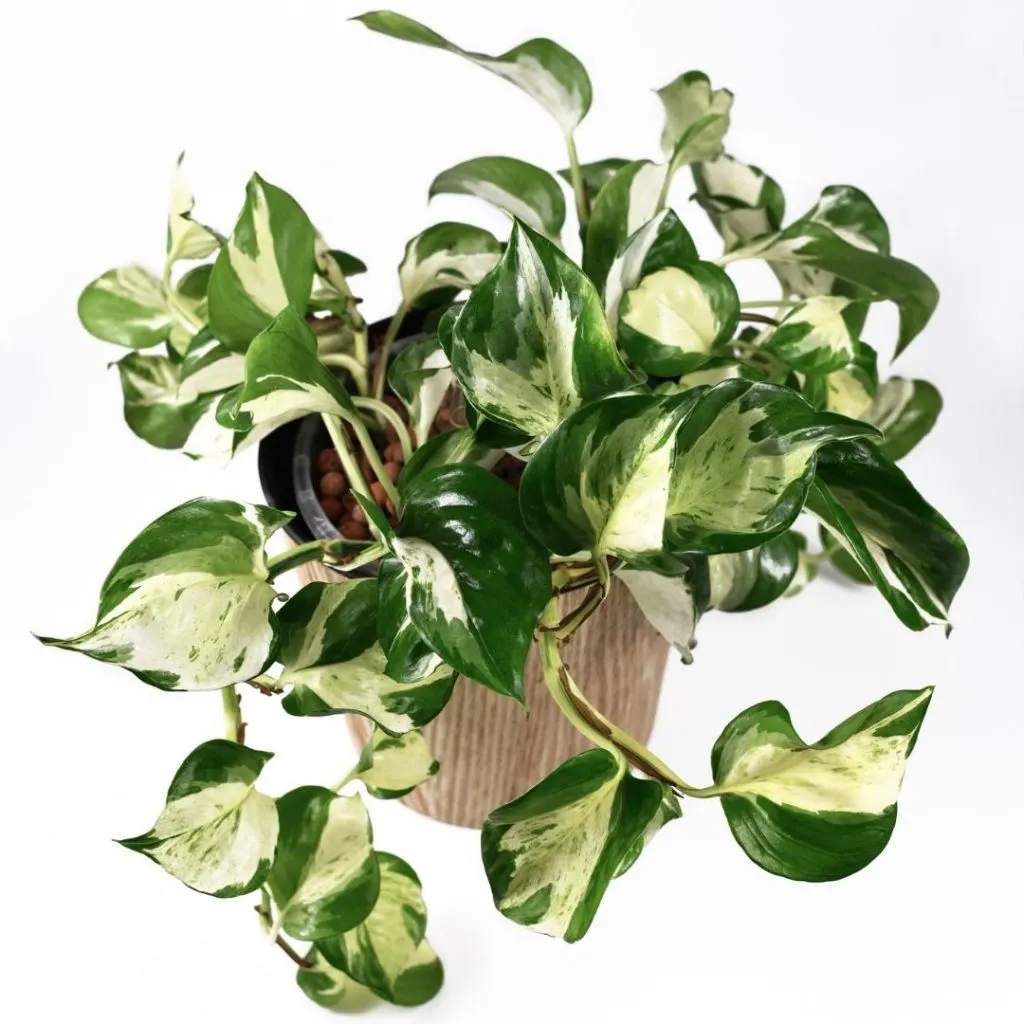
Where to Find Manjula Pothos:
You can’t expect to find the Manjula pothos in local garden shops. You might get lucky but I have never seen one in the local shops in our area.
However, you can find them on Etsy for under $20.00. We buy from Etsy when plants are not locally available from small reliable USA growers with good reviews. We have had good luck with Etsy.
Nowadays, the RAREST pothos is the Harlequin. Is the Harlequin a Manjula? Nope. The Harlequin pothos is a stunning mutation of the Manjula.
The Harlequin is even more difficult to find than the manjula and much more expensive. The Harlequin pothos is also available on Etsy if you have deep pockets. Its SO pretty!
How Can You Tell It’s a Manjula?
There are several variegated species of pothos. Some of them are closely related and easy to confuse. But there are distinct differences we can point out.
As they say a Picture is worth a thousand words. Take a look at our gallery below. We have some of the most similar variegated pothos labled.
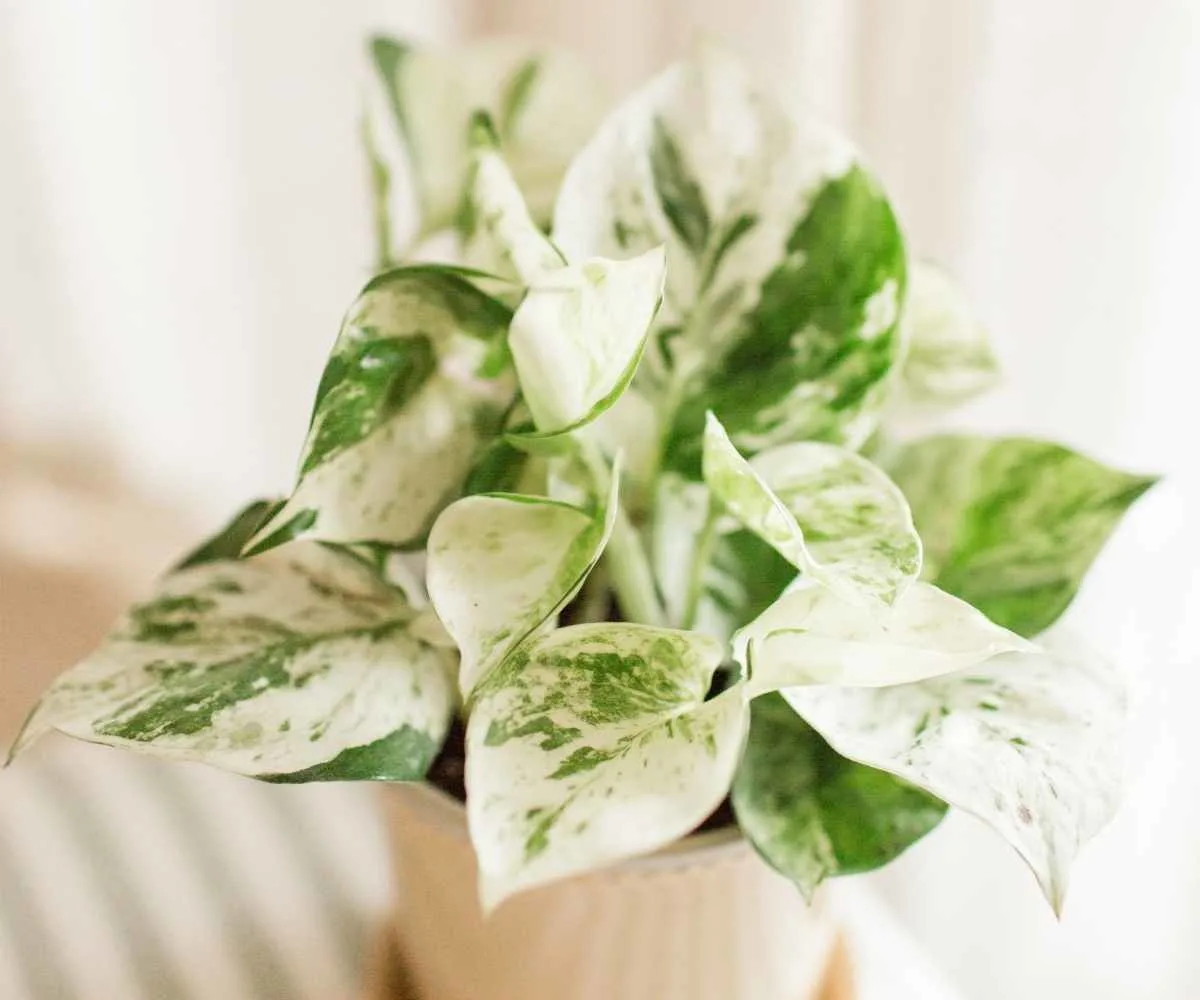
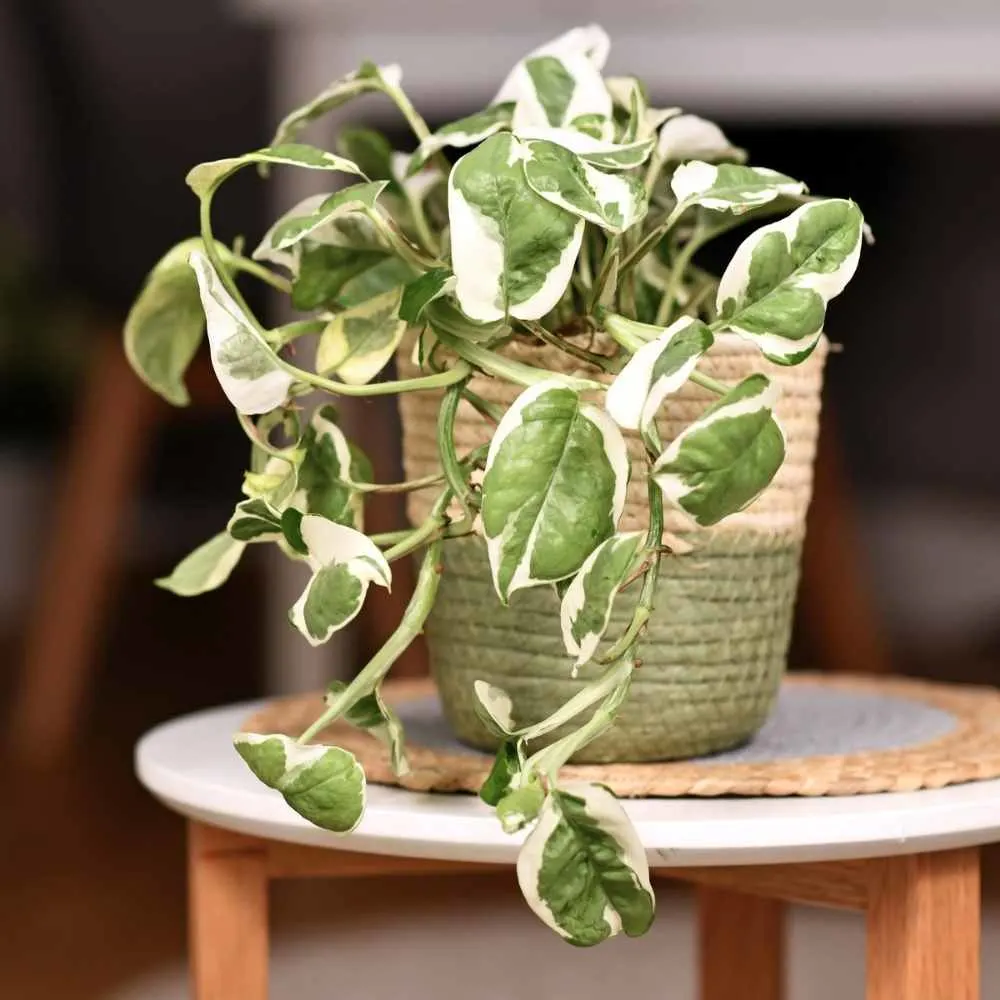
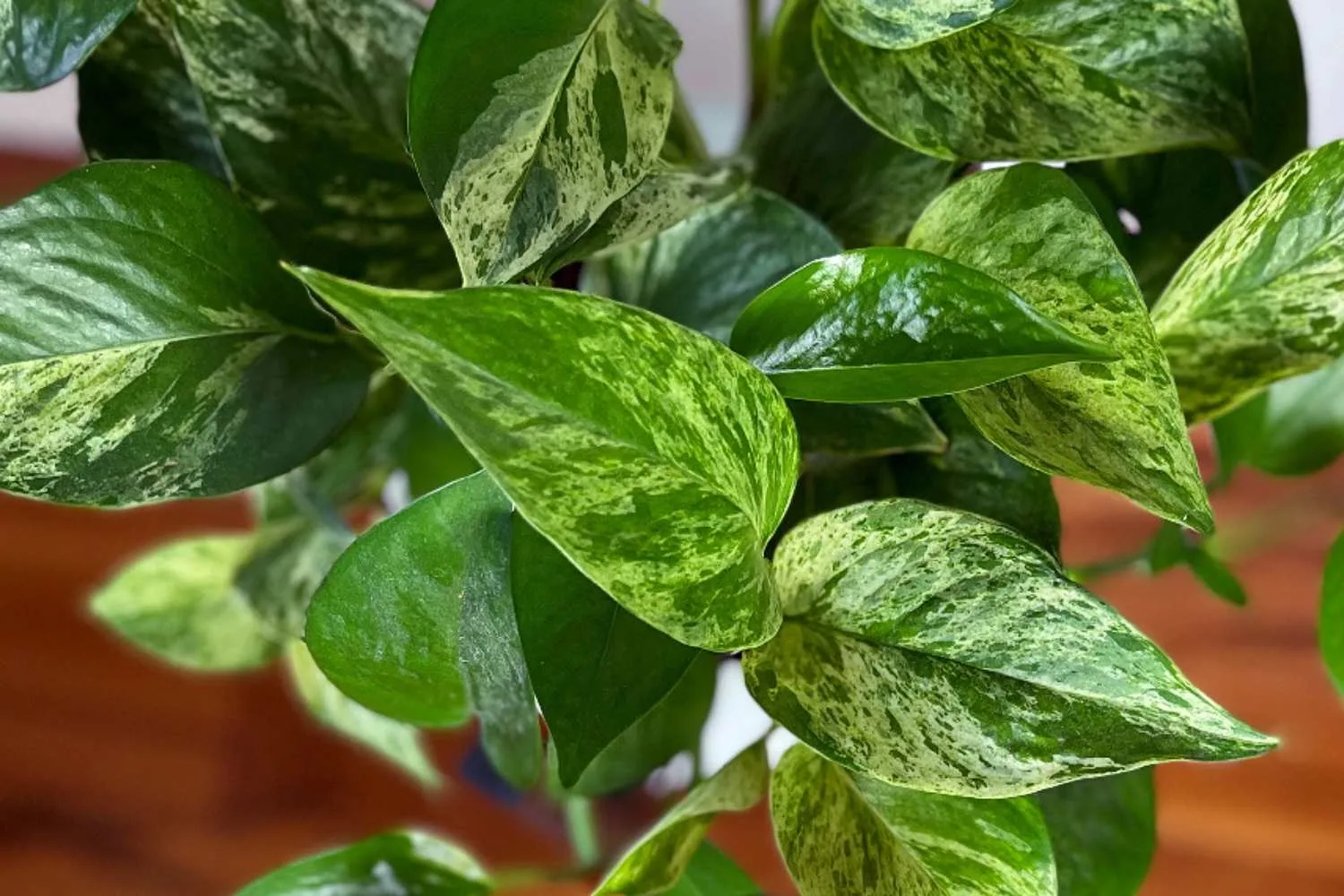
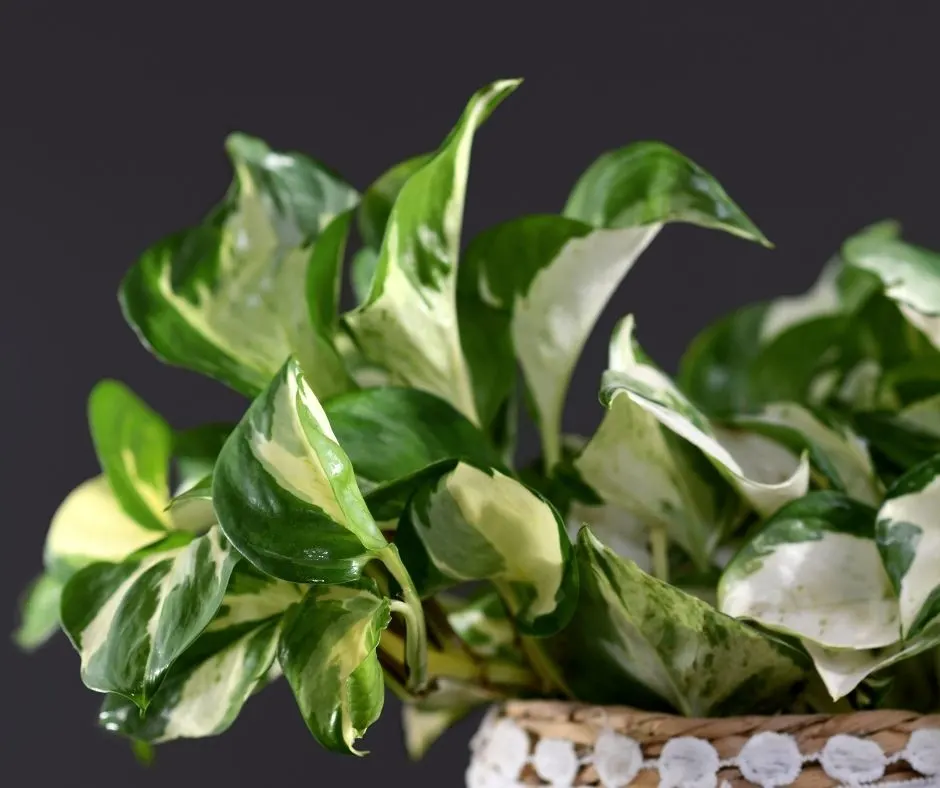
Manjula Pothos Vs. Marble Queen: the Manjula variegation pattern has some blurs and speckles like the marble queen but with more pronounced and defined white areas. Another distinguishing feature is the texture of the leaves. Marble queen leaves are smooth while the manjula has wavy leaves.
Pearls and Jade is easy to confuse with the manjula since it also has the marbling of the Queen along with the distinct white areas. But the manjula has a bit more distinct lines between the green and white.
Pothos N Joy is also commonly confused with Manjula since they both have wavy leaves and a similar color pattern. However, the pothos N Joy is bushier with shorter distances between the leaf nodes which make it curl in on itself as it grows. Manjula leaf coloring is also less distinct than the N Joy with a bit of blurring along the white edges.
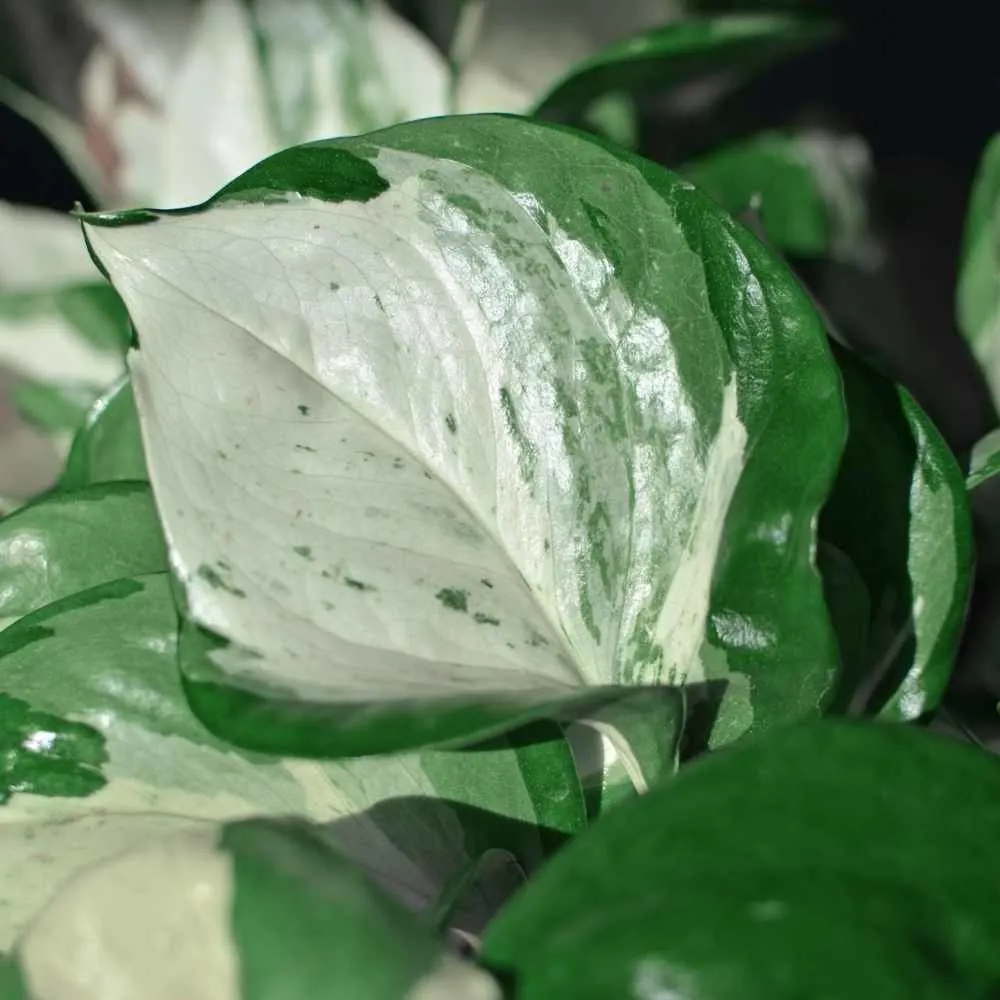
Trouble Shooting Problems For Manjula Care:
Reasons Why Manjula Gets Brown Spots on the Leaves:
Manjula Pothos brown spots can indicate over fertilizing, overly intense direct sunlight , low humidity, overwatering and root problems. Pests may also cause leaf damage resulting in brown or yellow spots.
The most Common problems with Manjula Pothos care stem from overwatering. If you see brown spots with yellowing of the leaves, it is probably due to overwatering which is turning into root rot. Avoid overwatering by keeping your Pothos on a regular watering schedule. And water only after testing the soil to see if it is dry down to the roots.
Over fertilizing can cause brown spots on leaves of your Manjula. Salts from fertilizers can accumulate in the leaves and burn them. This leaves ugly brown spots on the leaves.
The cure for accumulated salts in the soil is to flush the plant from the top with water for several minutes until the water comes out the drain hole for awhile. Now let the pot sit until it is completely drained in your sink. One good flushing should balance the salts in your soil.
Go lightly on fertilizing pothos plants.
Correct lighting is an important part of manjula pothos care. Manjula does not do well in strong, hot direct sunlight.
If you see brown spots on the leaves of your Manjula it may be getting sunburned. Notice how much direct light it receives. The leaves will burn if the sun is too hot and hits the leaves directly for many hours a day.
You may need to pull it back out of direct light if you have a strong western or southern exposure. You may have success also using shears to diffuse direct light.
Read More on Choosing the Best Lighting For Your HousePlants
Low humidity most often shows as brown leaf tips. Brown leaf tips mean you need to add a pebble tray under your plant with water and set the manjula close by. Humidifiers and grouping plants together will also help raise humidity to a higher level. Manjula prefers 50% humidity or greater. But 40% humidity is often enough for it.
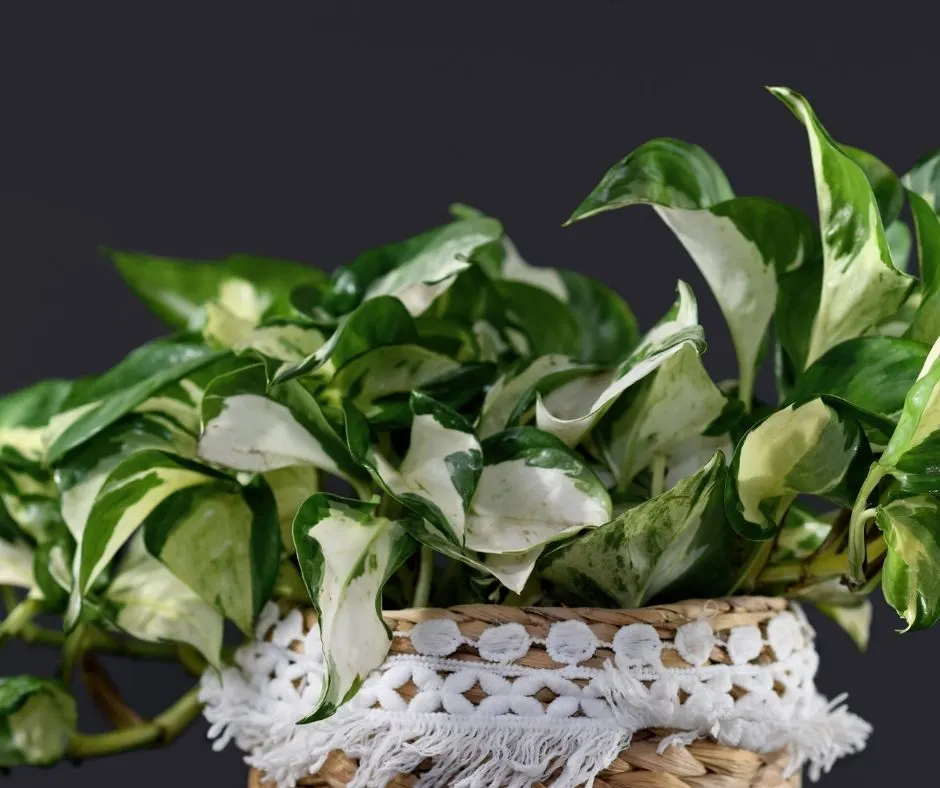
Why is Manjula Turning Yellow?
Yellowing leaves in Manjula is most often a sign of overwatering. When the roots are smothered by too much water they drown and die and rot. The plant quits feeding leaves since it has little or no roots and has to prioritize. Pests and poor soil or fertilizers can also cause yellowing leaves.
Read the seven reasons your plant has yellowing leaves in this post.
Why is My Manjula Turning Green? Can Manjula Revert?
Like all Variegated Pothos vines, the Manjula can revert to green foliage if placed in low light conditions for a prolonged period of time. The Manjula needs brighter indirect light to keep its variegation.
Over time Manjula will put out less variegation if it is not in a bright area. Reverting to solid or mostly green leaves happens in low light because the plant can only do photosynthesis from the green areas of its leaves. Chlorophyll is green and a necessary component of all plants.
White areas of a leaf cannot feed the plant. Manjula will begin to produce less white on its leaves to feed and protect itself. For best color and variegation, place your Manjula in a bright indirectly lit area.
How to Prune Manjula Pothos:
Manjula Pothos care includes pruning. These vines will easily grow as a hanging basket, on a high shelf where it can trail down, or trained up a trellis or moss pole. Manjula can be pruned to whatever size you want. They even make good table top plants.
Pothos vines naturally trail and climb. In nature, these strong vines climb trees and grow up to 60 feet with 2 inch stems and huge leaves. They can take over whole forests. If you live in a tropical climate keep your pothos in a container so it doesn’t become invasive. Pruning these out of your yard won’t be easy once they get roots in the ground.
Indoors, your manjula will behave much better and it is simple to train. As a houseplant Manjula vines will get about six feet long. If you don’t want that long length, trim off the extra at any leaf node on the stem. Small hand pruners or sharp scissors work well to prune these plants.
For climbing, your Manjula will need to be tied to the trellis or pole you want it to climb. It will grow up easily after it gets started.
Pothos vines do not grow INTO the attaching post and cling like English Ivy. You can simple drape them over the structure if they can lay on it and allow the vine to grow along it. Tying the vine on will ensure it stays where you want it.
More Pothos Plants:
There are many attractive pothos plants available. They are all easy care. Check out these varieties!

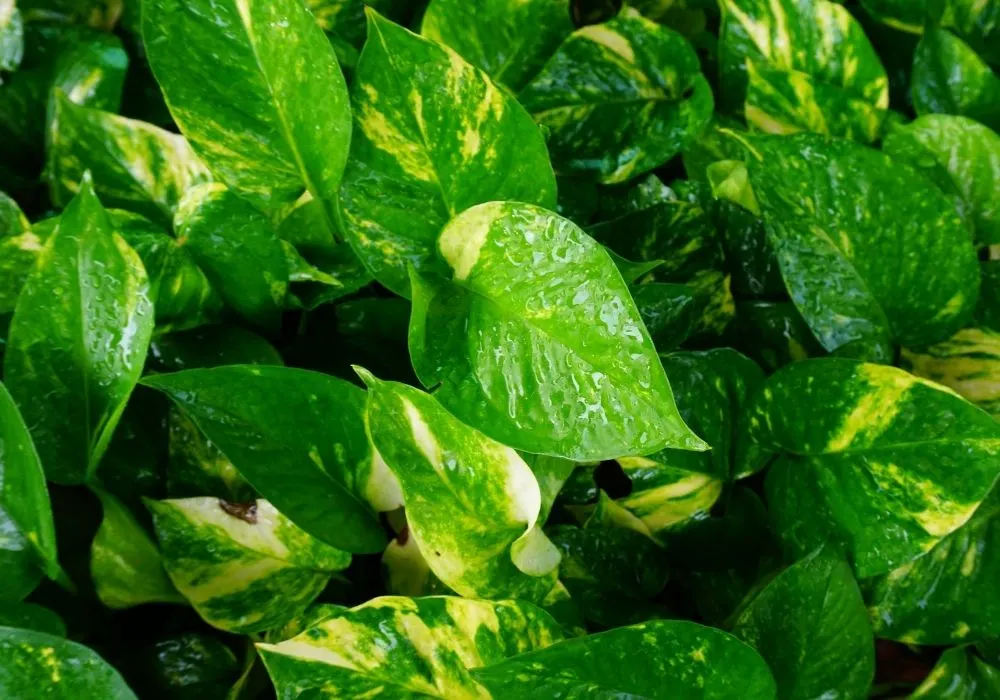
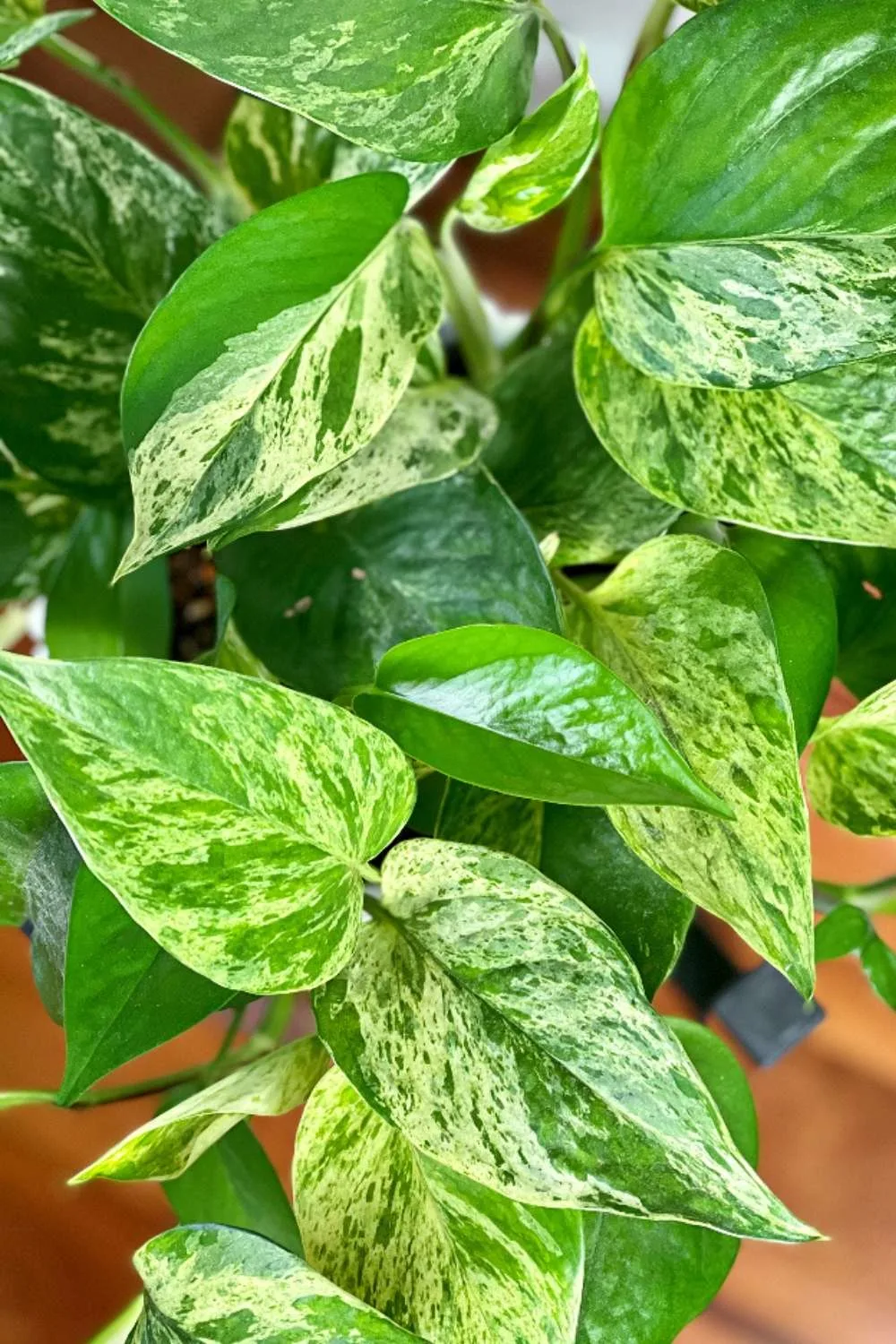
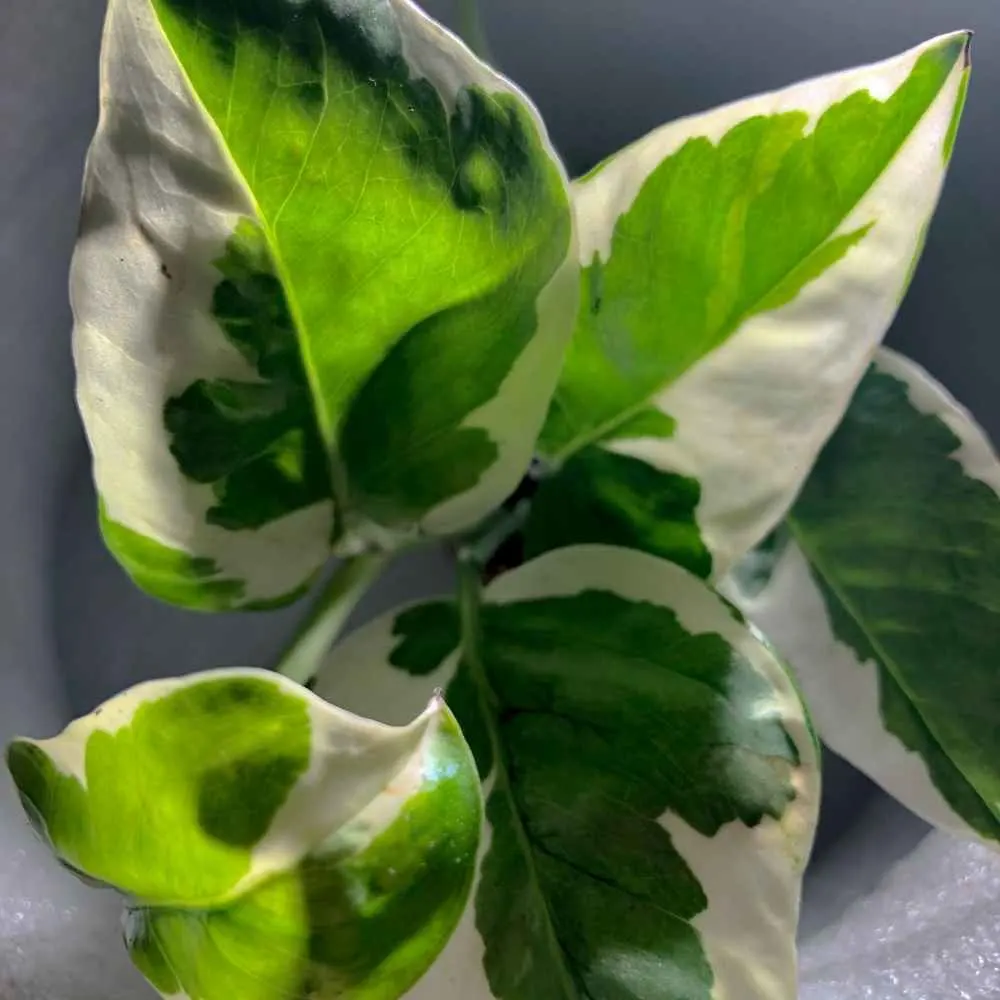
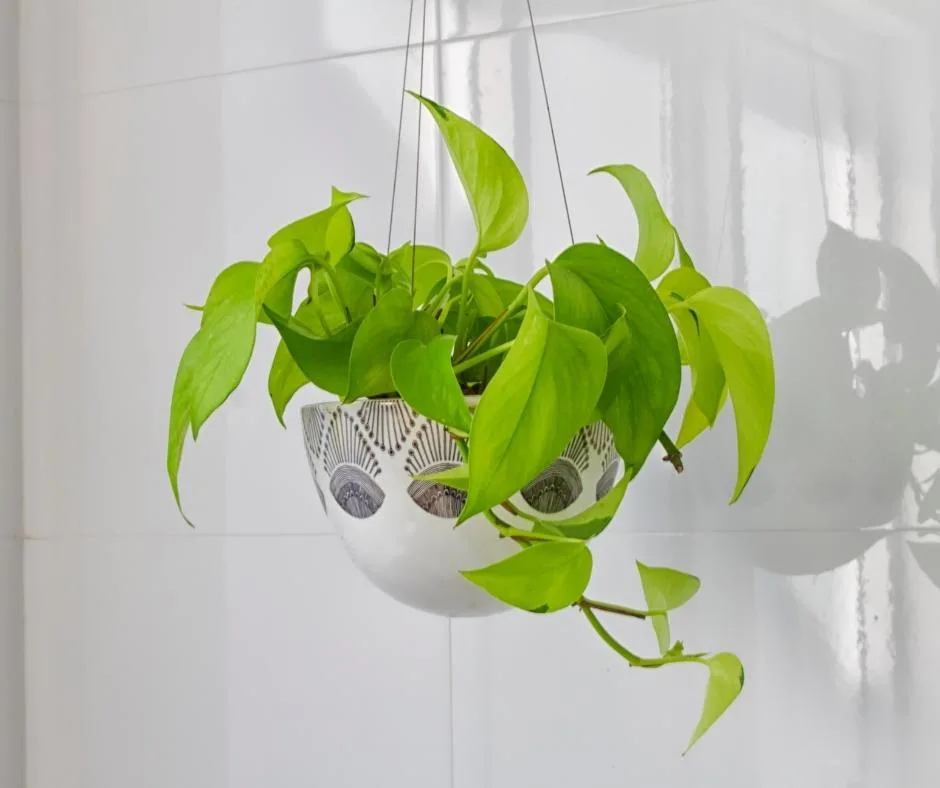
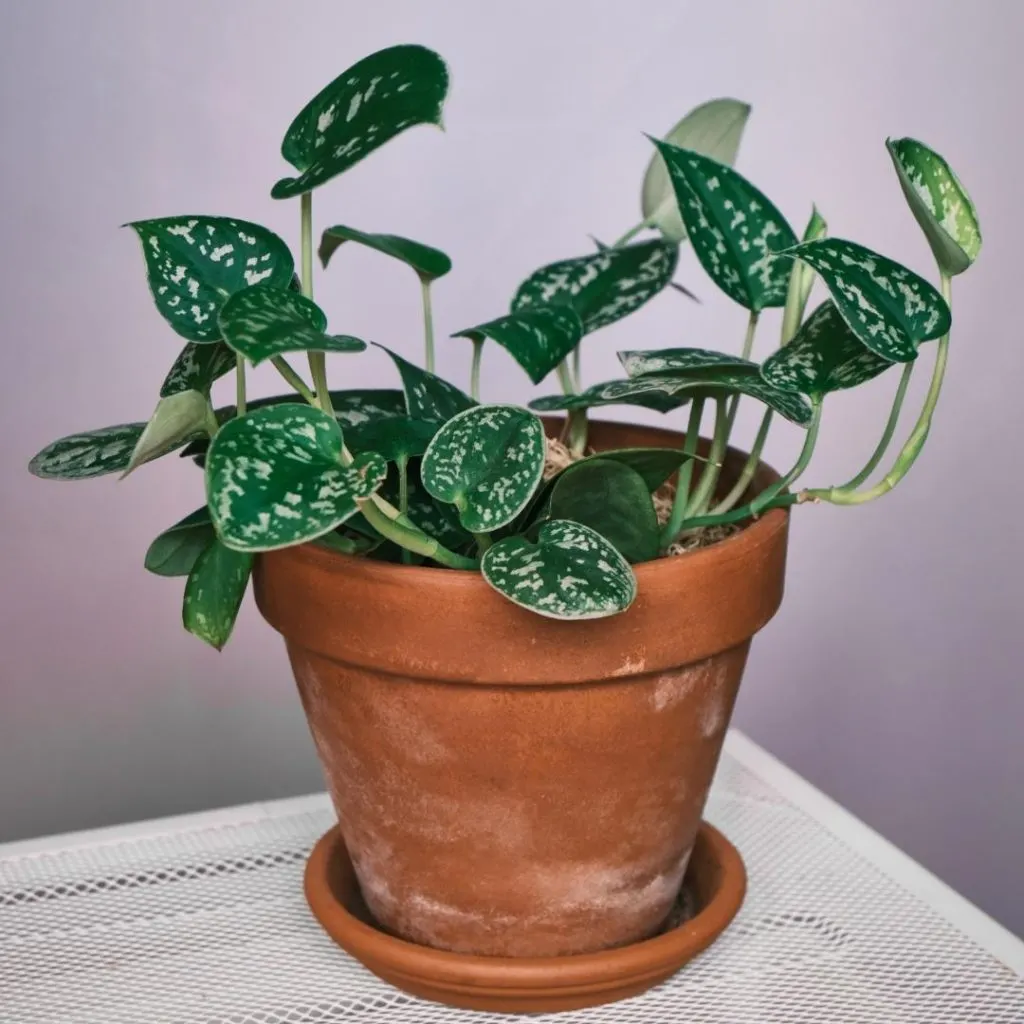
How do You Propagate Manjula Pothos?
All Pothos plants are extremely easy to propagate by stem cutting. If you are lucky enough to get your hands on a Manjula Pothos, you will probably have friends and family asking for cuttings.
The simplest way to propagate a Manjula is to take a stem cutting and place it in a cup of water, or your aquarium. In about 2 to 3 weeks roots will form. We have a post about propagating pothos that will show you how to multiply your Manjula with several easy methods.
How To Care For Manjula Pothos:
Manjula Pothos care is not difficult, we have put together a printable care guide that covers all the tips and tricks you need for a healthy plant.
Here is our quick care guide for the Manjula. At a glance you can see some key facts about this plant.
| Familiar Names: | Manjula Pothos |
| Scientific Name: | Epipremnum ‘HANSOTI14’. Manjula is a patented pothos variety. |
| Plant Family | Araceae |
| Care Difficulty: | Pothos plants are very easy to grow. Manjula will do well for you if it has good lighting, soil and proper watering. |
| Temperature: | 60 to 85 Degrees F. is the best temperature range for Manjlua with a humidity of 40% or higher. |
| Watering: | Water only when the soil is dry down to the root zone. Use your finger or a moisture meter to make sure the roots are almost dry before watering. Soak the soil and allow to dry before watering again. Err on the side of dryness for the Manjula. |
| Soil Mix: | Plant Manjula pothos in a light friable, well draining soil mix. Heavy dense soils hold too much water and may rot the roots. 70% potting mix to 30% perlite is a good mix for Pothos plants. |
| Lighting | Manjula tolerate low lighting but may lose variegation. Bright indirect light is optional for best color and growth. Harsh, direct sunlight will burn the leaves. |
| Growth | Manjula pothos grows as a vigorous vine. Indoors it can trail or be trained to grow on a trellis or up a pole. |
For more detailed printable Manjula Pothos care instructions be sure to look at our printable care guide below.
Manjula Pothos Care Guide
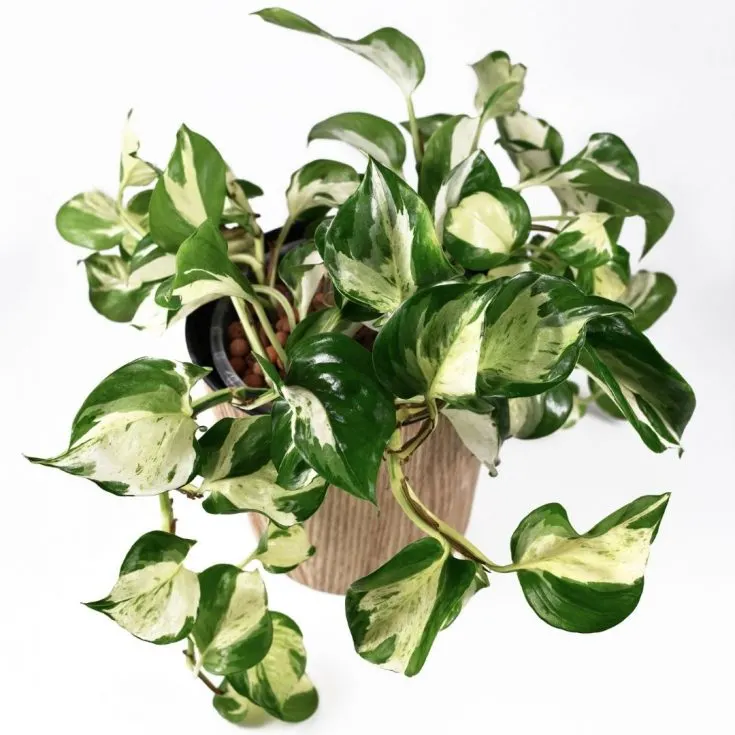
Manjula pothos have only a few basic requirements to remain a happy durable plant.
This lovely vine is a perfect beginner houseplant.
Materials
Instructions
Soil Preference:
- This aroid requires a light soil.
- A mix of potting soil and perlite will keep the roots happiest.
- Our mix for this pothos is 70 % potting mix to 30% perlite.
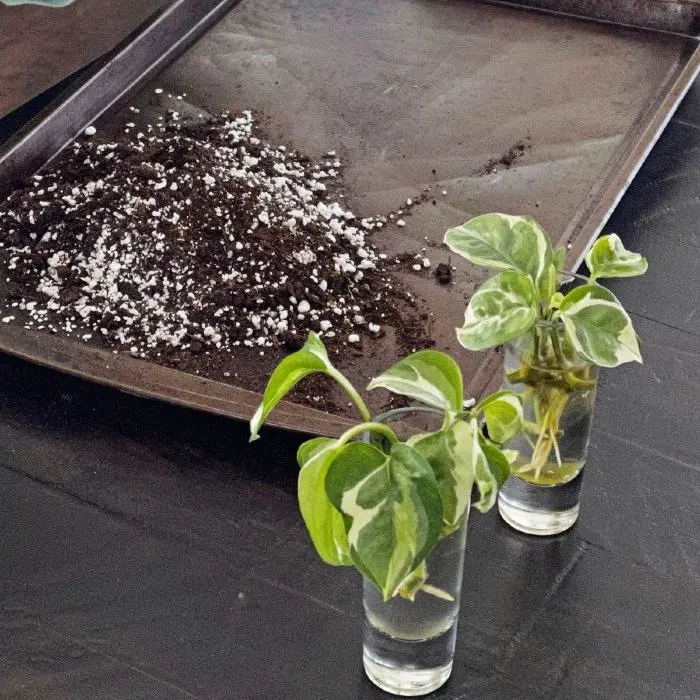
- A heavy soil potting mix is not recommended for Manjula plants.
Pot Size and Type:
- Pothos vines can be grown in relatively small pots since they are fairly slow growers.
- If you want to encourage faster growth choose a pot about 2 inches wider in diameter than the current pot.
- Any well drained pot can be used. It MUST have drainage.
- Repot every second year or when roots come out the drainage holes on the pot bottom To the next pot size up.
- Don't jump to a huge pot from a small one unless you wish to encourage faster growth. Just go to the next size up pot.
Lighting:
- The pothos vines enjoy indirect or dappled light.
It will tolerate lower indirect light it if has some brighter moments in the day. - Variegated pothos like the Manjula require more light to bring out the variegation in the leaves to best advantage.
- Some filtered sunlight from a window will be appreciated.
- Shield this aroid from strong direct light in summer south and west sunny windows. The leaves will burn.
- Tip: Window sheers or blinds can offset some brief periods of high direct light.
Watering:
- Water your pothos when the soil is dry down an inch or so. Aroids do not like to be overly wet. Try a watering schedule of every other week.
- Watering is best done on a regular schedule so the plant is not over or under watered. Both can cause stress on the plant.
- This tropical plant enjoys humidity. In dry climates this Pothos will thrive with a humidifier nearby. or set it in your kitchen or bathroom. For a really dry climate frequent misting will help.
- In dormant winter months reduce watering to when the soil is dry down halfway .
- Never let this plant get wet feet. If the soil is compacted and wet the plant is susceptible to root rot and fungus Gnats. If you see yellow leaves on Manjula you are probably overwatering.
How to Fertilize:
- Apply a good quality fertilizer (linked in materials) monthly through Spring and summer.
- Decrease feedings by late Fall and allow your pothos to rest through the winter months.
- Look for brown spots on the leaves of your plants. This may indicate an over concentration of salts in the roots from over feeding. It can burn the leaves.
- The remedy is to set the plant under a faucet of water and let the water run through for 10 minutes or so. Allow the pot to Completely drain. Discontinue fertilizer until the plant recovers.
Temperature:
- Keep pothos at a low of 65 Degrees F. to upward of 85 Degrees F. It enjoys warmth and humidity.
Pruning and Training:
- Pruning will give you a fuller plant with more even growth. Unpruned pothos vines will trail 8 to 10 feet.
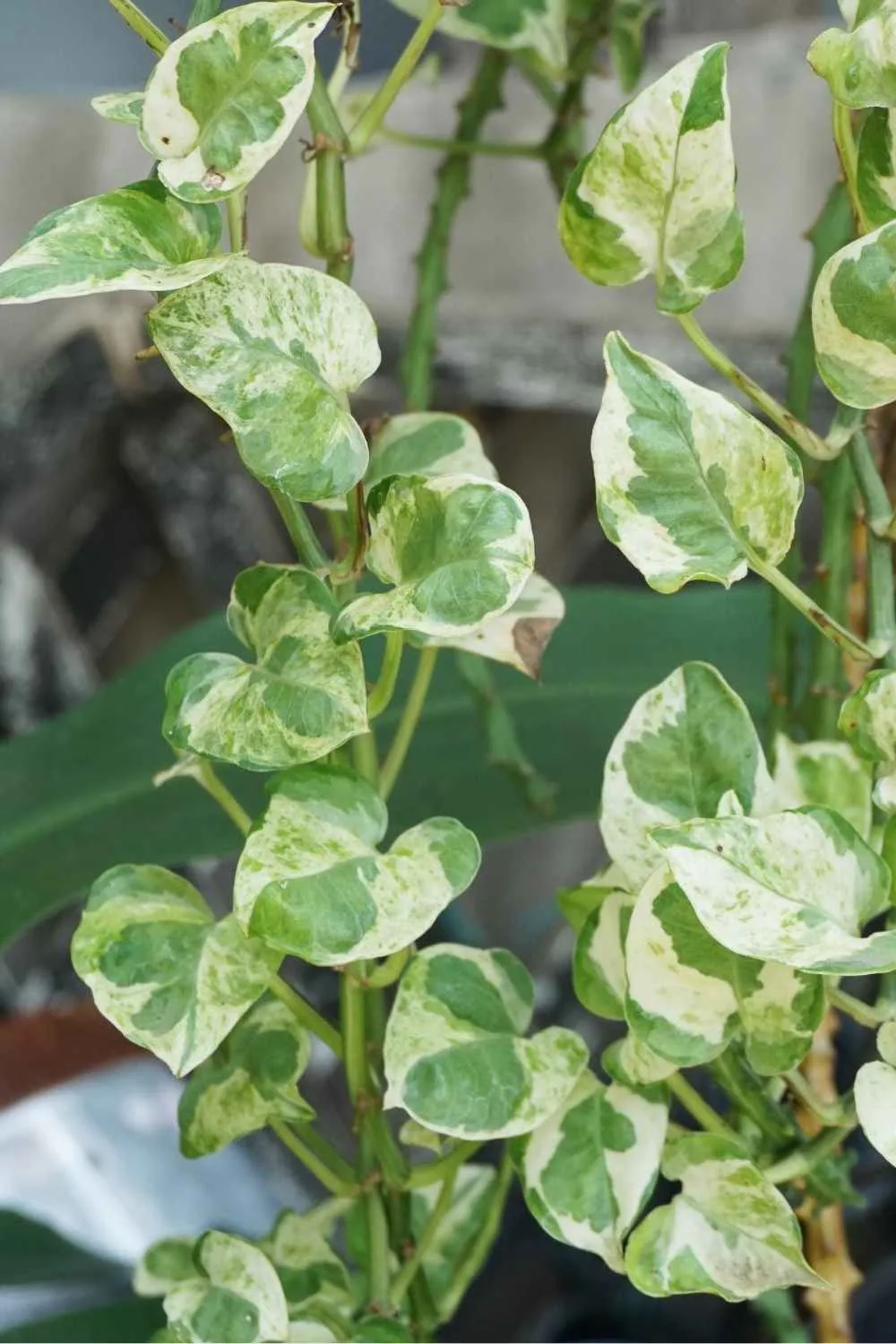
- Sharp Hand pruners are preferred for pruning. They will give a clean cut that will heal quickly.
- Pothos will naturally trail. They make good hanging baskets or they will happily trail off shelves. For even growth turn hanging pot every time you water.
Table Top Plants:
- It’s easy to prune and shape these plants to whatever length and fullness you desire.
- As a table top plant cut the trailers back evenly all around the pot. If you want the pot fuller add more starts.
Pests:
- Manjula pothos is not fussy and resists pests. However all plants can get attacked by pests.
- Stress by longterm poor watering practices, poor light, extreme temperatures and soil conditions are contributors to pests.
- Spider mites, mealy bugs, scale, thrips and whitefly are the most common houseplant pests you will see.
- Read our post on How to get rid of aphids and other pests with our homemade pesticide soap recipe or neems oil.
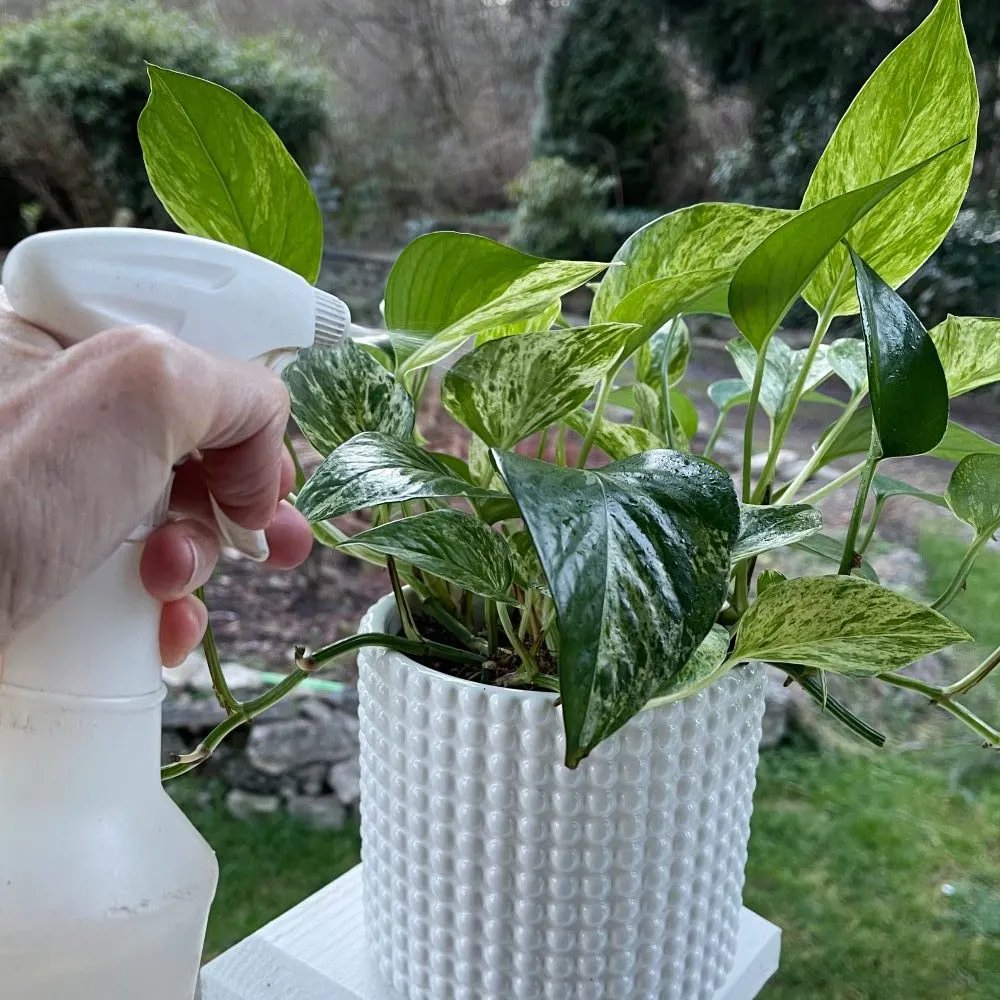
- To minimize the possibility of pests be sure to check all nursery plants before bringing them home.
- Quarantine all new plants until you are sure no pests live in them.
How to Propagate:
- Propagation is easily done through leaf node stem cuttings.
- You need a 3 to 6 inch leaf stem with a couple of nodes and healthy growth.
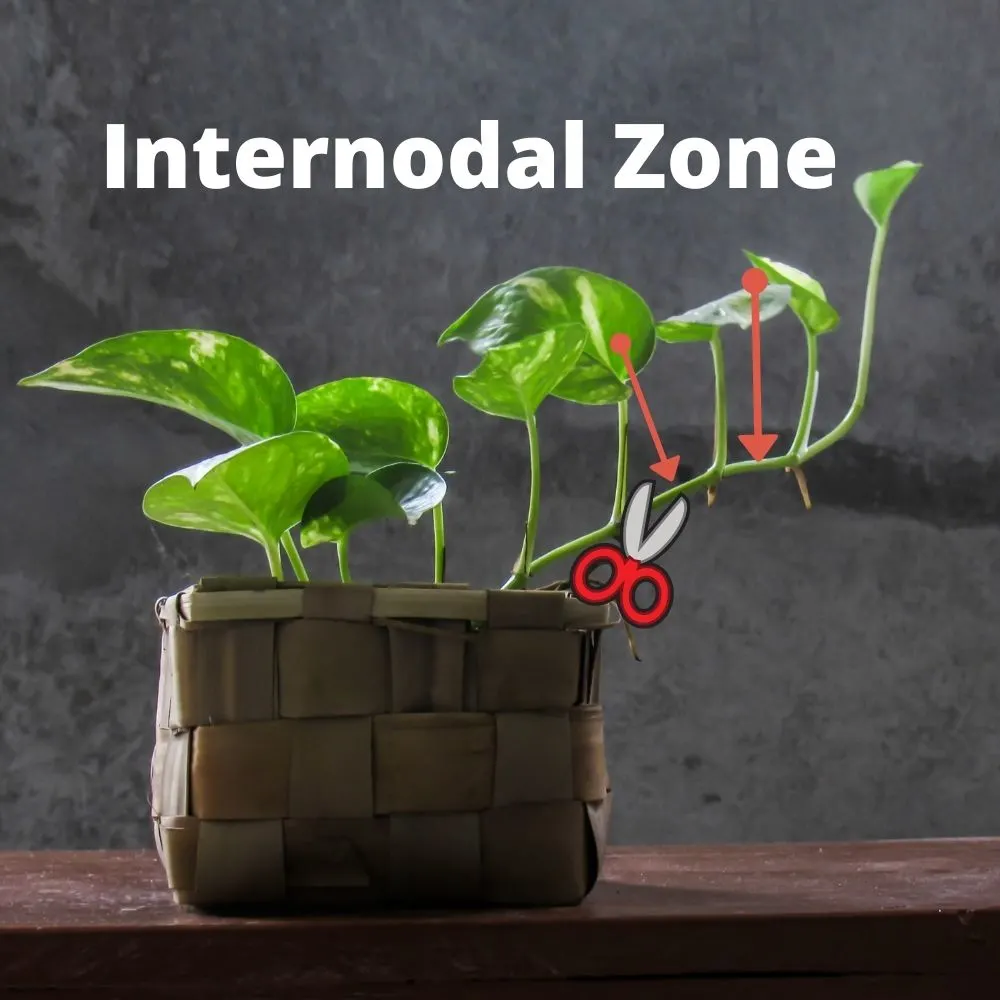
- Place the node into a jar with water. Use tap water that has settled 24 hours in the jar to dissipate chemicals harmful to the Pothos.
- Set the jar in a well lit area.
- After several weeks roots will grow. Allow the roots to get an inch or more in length.
- Plant gently and firmly into pot with proper soil mix.
- Make sure to keep the soil moist until the roots begin to set into the soil.
Notes
watch our video below for more on pothos propagation.
Follow Us:
Find us on YouTube, Instagram , Pinterest and TikTok! We love to Plant chat. We also comment, like and occasionally share your content to our daily stories. We’d love to see your plants. Share your joy in your houseplants. Happy Planting!
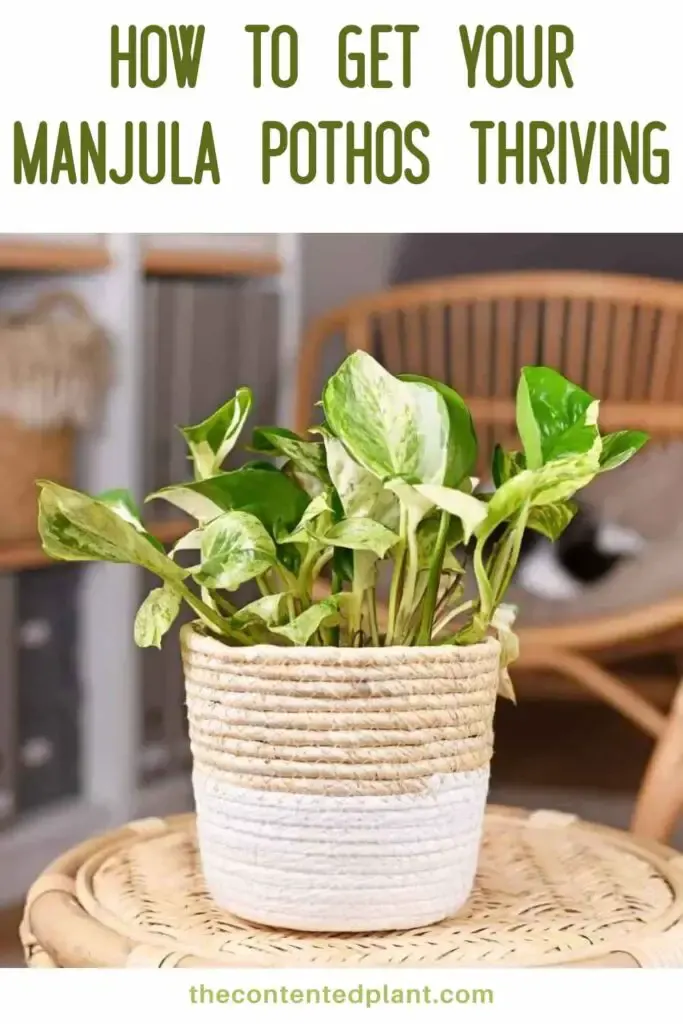
Read more about Pothos

Philodendron Burle Marx Plant Care Guide - The Contented Plant
Tuesday 31st of May 2022
[…] The Manjula Pothos […]
Pearls and Jade Pothos Care and Profile - The Contented Plant
Friday 27th of May 2022
[…] The Manjula Pothos […]
Monstera Adansonii Plant Care Guide - The Contented Plant
Saturday 31st of July 2021
[…] The Manjula Pothos […]